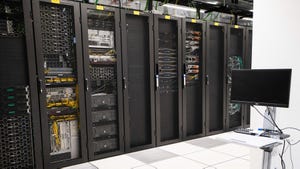Google’s Emissions Shot Up 48% Over Five Years Due to AIGoogle’s Emissions Shot Up 48% Over Five Years Due to AI
The increase was driven by higher energy consumption at its data centers and emissions from its supply chain.
July 3, 2024

(Bloomberg) -- Google’s emissions climbed by almost half over five years, as the company has infused artificial intelligence throughout many of its core products – making it harder to meet its goal of eliminating carbon emissions by 2030, according to a new environmental report from the tech giant.
The annual report was released Tuesday (July 2) and covers Google’s progress toward meeting its environmental goals last year. The Alphabet unit said its greenhouse gas emissions totaled 14.3 million metric tons of carbon dioxide equivalent throughout 2023. This is 48% higher than in 2019, the company said, and 13% higher than in 2022.
Google said higher energy consumption at its data centers and emissions from its supply chain were to blame and said its push to add AI to its products could make it more difficult to reduce emissions going forward.
“As we further integrate AI into our products, reducing emissions may be challenging due to increasing energy demands from the greater intensity of AI compute, and the emissions associated with the expected increases in our technical infrastructure investment,” Google wrote in the report.
For several years, the Mountain View, California-based company has said it plans to eliminate such emissions from its operations by 2030.
AI – and in particular generative AI, which takes in user inputs and spits out new content like text, images, or songs – is extremely resource-intensive, as a recent Bloomberg News investigation showed. As the technology grows rapidly, more and more data centers are needed to build and run it, leading to surging power requirements.
The dramatic increase in power demands from Silicon Valley’s growth-at-all-costs approach to AI threatens to upend the energy transition plans of entire nations as well as the clean energy goals of trillion-dollar tech companies.
In some countries, including Saudi Arabia, Ireland and Malaysia, the energy required to run all the data centers they plan to build at full capacity exceeds the available supply of renewable energy, according to a Bloomberg analysis of the latest available data.
Google is not the first major technology company to cite the rapid growth of AI as an obstacle to achieving environmental goals. In May, Microsoft Corporation said its carbon emissions climbed 30% since 2020, as the company increasingly invested in AI. The increase made that company’s target of getting to below net-zero emissions by 2030 even harder than it was when it announced its carbon-negative goal.
Sasha Luccioni, climate lead at startup Hugging Face, said the data show tech companies weren’t anticipating the massive growth of AI when they set their environmental goals. “They couldn't have,” she said. “The baseline year in that Google report was 2019 – definitely not anticipating it.” Companies have been blindsided both by how much energy is required to build such technology, Luccioni said, and how much energy is required to run it.
About the Author
You May Also Like









